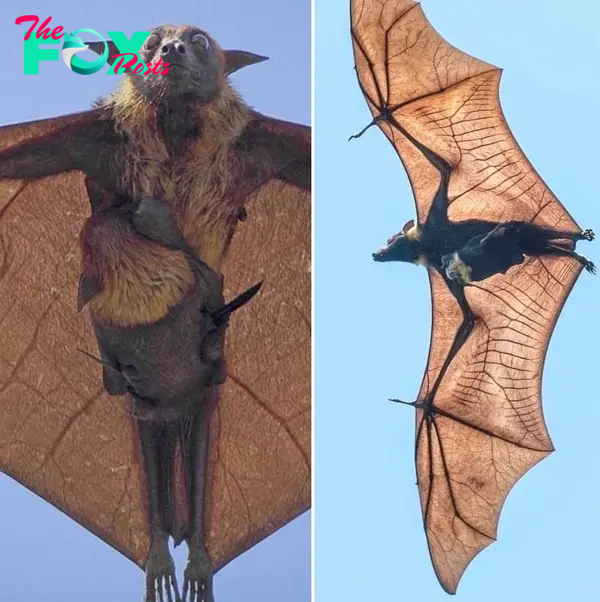Mysterious
S29. Meet the Giant Golden-Crowned Flying Fox: Earth’s Largest Bat Species. S29
The Giant Golden-Crowned Flying Fox, known scientifically as Acerodon jubatus, holds the distinguished title of being the largest bat species globally. Its awe-inspiring size and unique appearance have captured the fascination of many wildlife enthusiasts and researchers alike. This remarkable creature is native to the forests of the Philippines, particularly in the islands of Luzon, Mindoro, and adjacent smaller islands.
One of the most striking features of the Giant Golden-Crowned Flying Fox is its impressive wingspan, which can reach up to an astonishing six feet or more. This remarkable wingspan enables it to gracefully glide through the forest canopy with remarkable agility and precision. Despite its large size, this bat is incredibly light, thanks to its thin, membranous wings that are supported by elongated fingers.
As its name suggests, the Giant Golden-Crowned Flying Fox Sports a distinctive golden-brown fur on its head, which contrasts beautifully with its dark-colored body. This golden crown adds to its regal appearance, earning it the epithet “Golden-Crowned.” Its fur serves not only as a visual adornment but also as insulation against the cool forest nights.
In addition to its remarkable physical characteristics, the Giant Golden-Crowned Flying Fox plays a crucial role in its ecosystem as a keystone species. As a frugivorous bat, it primarily feeds on fruits, playing a vital role in seed dispersal and forest regeneration. By consuming a variety of fruits and flying over vast distances, these bats contribute significantly to the maintenance of biodiversity and the Health of the forest ecosystem.

However, despite its ecological importance, the Giant Golden-Crowned Flying Fox faces numerous threats to its survival. Habitat loss due to deforestation, primarily driven by logging, agriculture, and urbanization, poses a significant risk to its population. The destruction of its forest habitat not only diminishes its available food sources but also disrupts its roosting sites, which are often located in large colonies in tall trees.
Furthermore, the Giant Golden-Crowned Flying Fox is also hunted and persecuted by humans, primarily due to misconceptions and fear. Some communities view bats as pests or carriers of disease, leading to indiscriminate killing or persecution. Additionally, the illegal wildlife trade poses a threat, as these majestic creatures are sometimes captured and sold as exotic Pets or for their purported medicinal properties.

Conservation efforts aimed at protecting the Giant Golden-Crowned Flying Fox are crucial for ensuring its long-term survival. Initiatives focused on habitat preservation, such as establishing protected areas and reforestation projects, are essential for safeguarding its natural environment. Furthermore, raising awareness about the importance of bats and dispelling myths and misconceptions can help foster coexistence between humans and these remarkable creatures.
Research into the behavior, ecology, and population dynamics of the Giant Golden-Crowned Flying Fox is also vital for informing conservation strategies and management plans. By understanding its habitat requirements, feeding habits, and reproductive biology, conservationists can develop targeted interventions to mitigate threats and support Healthy populations.

In conclusion, the Giant Golden-Crowned Flying Fox stands as a symbol of both the wonders of nature and the challenges faced by wildlife in an increasingly human-dominated world. Its remarkable size, beauty, and ecological significance make it a species worthy of admiration and protection. By working together to address the threats it faces and conserve its habitat, we can ensure that future generations will continue to marvel at the sight of these majestic bats soaring through the forest canopy.
-

 Mysterious2w ago
Mysterious2w agonht.”Exploring Humanity’s Pursuit of the Legendary 9-Meter, 4-Ton Giant.”
-

 Mysterious2w ago
Mysterious2w agonht.Once-In-A-Lifetime Footage Of A Massive Humpback Whale Leaping Out Of The Water Next To A Fishing Boat
-

 Mysterious3w ago
Mysterious3w ago.Global Sensation: Mesmerizing Footage of Giant Prehistoric Swordfish Captivates Audiences..D
-

 Mysterious3w ago
Mysterious3w agonht.The discovery of a peculiar creature with human and fish-like features is causing a stir on social media.
-

 Mysterious3w ago
Mysterious3w agonht.Google Maps reveals a possible extraterrestrial portal near Area 51, sparking widespread interest in the UFO community.
-

 Mysterious3w ago
Mysterious3w ago.Heroic Act: Rescuing Live Turtles from Fish Markets and Returning Them to the Ocean..D
-

 Mysterious3w ago
Mysterious3w agoB83.Exploring the Universe: Alien Forms and Their Extraordinary Means of Transportation Revealed
-

 Mysterious3w ago
Mysterious3w agoB83.The Goblin Man: A Remarkable 5,500-Year-Old Mummy and the Secrets of His Preservation


























